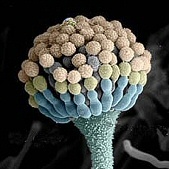Toxins

Toxins, and especially mycotoxins, are a severe problem in the animal feed industry. Mycotoxins are toxins produced by mushrooms, molds and yeasts and come to the forefront when maize or grain are badly stored (in wet areas for example).
When we include more cereals in dry petfood, the risk of mycotoxicoses in pet animals increases. Most obviously affected are dogs and cats, but mainly because cases are identified.
Increased problem
It is generally recognized by petfood manufacturers that mycotoxin contamination is a source of increased problems in their industry. The major mycotoxins with potential for contamination of pet foods are aflatoxins,vomitoxin, zearalenone, fumonisins, and ochratoxin A. Three genera of fungi, Aspergillus, Penicillium, and Fusarium (Gibberella), are the most frequently implicated causes of mycotoxin contamination.
The primary target organ for aflatoxins is the liver with liver disease resulting from dogs ingesting aflatoxin-contaminated dog food. Little is known about the toxicity of vomitoxin, known chemically as deoxynivalenol (DON) in pets. It is known that dogs are susceptible to relatively low levels of vomitoxin and exhibit health problems similar to that seen in swine. Cats, as well as cattle, poultry, and humans, can also be affected.
There are no reports that zearalenone have caused clinical signs in dogs or cats. Fumonisins interfere with cell membrane metabolism and the signs of toxicity vary with species. The only studies conducted to demonstrate the effects of fuminosins in pet species has been in rabbits. Ochratoxin A is a nephrotoxin (i.e. toxic to the kidneys) and is also teratogenic (i.e. causes fetal malformation during the first three months of pregnancy) in all species tested. It also impairs the immune system and is a suspected carcinogen.
Testing
In order to deal with the potential occurrence of mycotoxins in pet foods, pet food manufacturers currently employ mycotoxin testing programmes. These programmes include the screening of incoming ingredients prior to their utilization in the formulation of pet foods, both by suppliers and manufacturers. As well, manufacturers perform periodic analysis of pet food products for mycotoxins.
See also:
Article – Mycotoxins in pet food, rare but ruthless
Article – Keep mycotoxins in pet food on the leash











